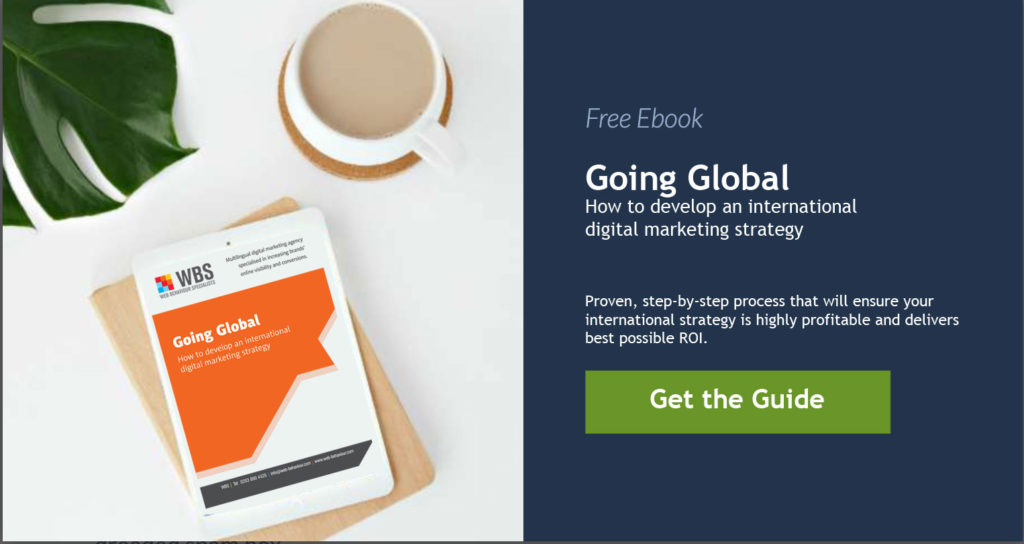There are different reasons why you may need an international digital marketing strategy, such as expansion into new markets or opening your online offering to similar audiences in different countries. Digital marketing is a great way to reach global audiences, which might be interested in your products or services.
Global expansion needs t careful plan and a digital marketing strategy plays an important role in this. Reaching an international audience, however, also entails understanding regional cultures, laws and online behaviours.
The basics of developing a digital marketing strategy are the same as those of developing a domestic plan. Basic steps include market research, setting goals, choosing the relevant channels, designing the actual plan, and monitoring and adapting.
Market research is the base of any successful marketing strategy and becomes even more important when going global. Similarly, an international digital marketing strategy has important aspects which are not in a domestic strategy. These international elements touch every aspect of digital marketing, including SEO, content, website design, PPC and Social Media. These elements will be in this paper, starting with Market Research.
Market research – international implications
How do we know if there is even a market for our products or services in the country/countries we are hoping to expand into? For example, it might sound great to expand our business into Italy, but what if there is no need for our products or services there? What key elements should we research?
The target audience – who are they and how do they behave online?
Hopefully you know who your target audience is, as that is one of the most important elements of research. To successfully expand into new markets we need to research elements such as:
- Is the target audience for your products or services the same across countries?
- Do they shop online or mostly offline in store?
- What marketing channels do they use?
- Which social media platforms do they use, and how do they engage with them?
- When are they active online, what devices do they use?
- Who are the key influencers, etc.?
For example, if our target audience is 50+ years old, but in our targeted country the majority of Internet searches are by 18-40 year-olds, you may want to consider other forms of advertising.
The competition – who are they and what do they do?
Competitive landscape research is an essential step as our competition will most likely be different in each country.
- Who are our main competitors in the specific markets, both direct and online?
- Do they have a digital presence and what is their digital strategy?
- What are their online and offline efforts and how successful are they?
- Do they have a strong social media presence?
- Do they have a content strategy in place?
- Are they working with key influencers?
Use the insights gained from your competitor analysis to prepare for your entry into the new market. Look at what worked for them, and avoid any mistakes they may have made.
Cultural habits and differences
We need to be conscious of the fact that people in other countries are different. It is key to understand your local audience’s habits and behaviour to build successful campaigns in different markets. We should be aware of demographics such as education, standard of living, internet penetration, as well as attitudes towards online buying. Cultural elements such as religion and value systems, social interactions, even the meaning of colours and symbols are important.
penetration, as well as attitudes towards online buying. Cultural elements such as religion and value systems, social interactions, even the meaning of colours and symbols are important.
These nuances, sometimes small, sometimes large, should also influence your decision on the type of promotion you are going to use in the specific country. For example, in China users generally trust paid search results more than organic results, so if you are planning expansion in this market, you should start with paid advertising and support this with SEO.
Design implications
Website and marketing materials design can also be impacted by cultural and linguistic factors. For example, the German language has some very long words that will need to fit onto mobile screens. For some languages with special characters you will need to use a font that supports them. In Arabic countries they read sentences from right to left, which we have to take into account when designing website navigation.
You can’t forget about the images that will be on the website or marketing materials. Choose images that will be relevant to your international audience or adapt them to the local country. For example, will an image of Big Ben work for the American audience?
Local laws – are there legal implications?
Regardless of the products or services you offer, you should also be aware of local laws. Certain countries might have their own licensing, taxation and compliance requirements, which you will need to be familiar with. For example, in Germany you need to comply with EU Comparative Advertising if you want to use this type of advertising
Logistics – how do we provide quality customer service?
It is really easy nowadays to expand your offer to other markets online, but we can’t forget service and logistics. For example, you need to think about how you are going to handle the phone calls or enquiries in a new language/country, or make sure that the international deliveries are efficient.
The online world is a great way to increase awareness in new markets and engage with new customers. However, we can’t forget that our online efforts shou adapted to the local markets and take into account cultural differences. We need to be sensitive to cultural differences that influence decision-making and buying behaviour. Having an understanding of these differences can become a competitive advantage.
There is no other way to get this information than through basic Market Research. Only once we have this can we go on to the next phase of designing the digital marketing strategy.
Localisation
Localisation is the process of adapting language, communication strategies and content to the audience you are targeting, based on their location and culture. What is important to note here is that just translating the content is not enough. All our marketing materials, offerings, website, etc. need to be localised.
Localising content
Speaking your customer’s language is not only vital for performing well in search engines, it is also essential for brand visibility, establishing trust and competing with local businesses.
Statistics also show there are good reasons for localisation:
- Customers are four times more likely to buy from a website in their own language
- 70% of global search queries are not in English
- 90% of European internet users visit websites in their own language
 In order to make your content/offering as engaging and compelling as possible, you must maintain the quality of the content and allow extra budget for translation. We recommend to hire a translation agency that works with native speakers or a freelance native speaker to localise your content.
In order to make your content/offering as engaging and compelling as possible, you must maintain the quality of the content and allow extra budget for translation. We recommend to hire a translation agency that works with native speakers or a freelance native speaker to localise your content.
Localisation is important even when we are targeting the same language but in different countries. For example, a UK company expanding into the US should also localise its content and use local spelling, e.g. color vs. colour, or localize vs. localise. It makes a difference in the user’s eyes and increases trust.
Localising the website
Offering content on your website in multiple languages is merely the first step towards localising your website. To achieve best results we should also localise the following:
- URLs – these should be in local language and include strategic keywords to support local SEO efforts and increase user trust
- Images – these should be relevant to your international or local country audiences
- Contact details – whenever possible, have a local phone number listed on the site so potential customers can contact you
- Customer service – think how are you going to handle the phone calls or enquiries in a new language/country
- Currency – whenever possible offer users the option to pay in the local currency
- Payment methods – make sure that you offer the most popular payment methods for the specific country
- Meta elements – localise all meta elements, such as, title tags, meta descriptions, heading tags, alt tags, internal linking, etc.
It is so easy nowadays for potential customers to leave your website if they do not like it because the content is not in the local language, if they do not like the tone of the content or the images used do not look or feel relevant. As a website is the first step towards establishing a digital presence in another country, getting it localised is crucial.
SEO – optimising for the international audience
Search engine optimisation is essential to ensure your website is getting maximum visibility to your target audience in the new country. As mentioned, the principles of SEO are the same across countries, but there are a few elements, which need to take into consideration for international expansion.
Search engines
Google is the biggest search engine in a majority of countries in terms of market share. However, there are a few exceptions. For example, if you are going to trade in countries like Russia, your online marketing activities should be on the Yandex search engine, which has 64% market share. In China the dominant search engine is Baidu (79% market share) and in Japan it is Yahoo (51% market share).
Knowing which are the leading search engines in a targeted country and what their ranking criteria is, is crucial to ensure visibility to your target audience.
Keyword research
The keywords we use to look for information, products or services in search engines vary from country to country. As with localisation discussed earlier, this does not only apply to different languages, but also to countries, which speak the same language. Keywords used in Germany are not necessarily the same as those used in Austria or Switzerland.
 To properly optimise our content on the site, we should do the research for the most popular and important keywords in the local language for the specific country. Furthermore, our research should be performed through the leading search engines.
To properly optimise our content on the site, we should do the research for the most popular and important keywords in the local language for the specific country. Furthermore, our research should be performed through the leading search engines.
While we can localise our content (website, offer, marketing materials, etc.) with the use of a translation agency, we need to go deeper with the keyword research to properly optimise our site for search engines. For example, if we have a list of popular keywords related to our products in English, the translation agency can help us discover what the preferred search terms are in the targeted language. However, it is not a guarantee that the translated keywords are the most used in a specific country or language.
Content strategy
Our content should be optimised for relevant local keywords and presented in a user-friendly way. Content should tailor to the needs and interests of your audience in the specific country in order to build trust around your brand, products and services.
Learn how to design an effective content strategy
How should we approach the content strategy with multiple languages or countries we want to target? As with the keyword research, we need to start with the local research. For example, if we target French speakers, our research should be in French with focus on the countries we want to target (France, Switzerland, Canada or all of them).
If we are planning to update our content regularly via, for example, a blog section, we can’t assume that we can just translate English posts into other languages. We need to do our research by country/language to decide what type of content users want to read. Local research will help us understand differences in search habits, for example, which keywords are used during search, what problems are users trying to resolve, etc.
We might find that there will be some universal content with which we can target all markets, in which case the localisation process will be enough. However, we will definitely also discover that users have different search habits and behaviours, and that there is a need for a separate content strategy per market/language.
Schema markup
Structured data can help you to send the right signals to search engines about your business. You can leverage Organisation or LocalBusiness schema markup to impact your local listings and indicate your physical address, opening hours, payment types accepted, etc., for the specific country.
Geotargeting– the technical side of SEO
Although we don’t want to go into too much detail on the technical aspects of SEO, there are several important elements, which you should look at in the early stage of internalisation.
Domain structure
Domain structure is an important part of your international digital marketing strategy. There are three commonly used approaches for creating multilingual domain/URL structures, namely: (1) ccTLD (country code top level domain); (2) subdomain and (3) subdirectory. Some brands also use URL parameters, but it is not a recommended approach. There are pros and cons to each approach, which you should consider before making the selection.
ccTLDs – country code top level domain
Examples: France.fr, Germany.de
ccTLDs are the single strongest way to show search engines and users that the site content target specifically a certain country or region. It is a trust signal for users and sends clear geotargeting signals to search engines.
On the other hand, a ccTLD requires a separate SEO strategy to build up the authority for each site separately. Furthermore, each domain requires technical support and incurs hosting costs. You may also encounter an availability issue if your domain is not available in one of the markets.
Subdomains with gTLDs (generic top-level domain)
Examples: fr.France.com, de.Germany.com
Subdomains with a generic top-level domain are easy to set up and maintain. You can take advantage of geotargeting options in Google Search Console. On the other hand, subdomains have weaker geotargeting signals than ccTLDs for search engines, and users might not recognise it from the URL alone (e.g. is ‘de’ the language or the country?).
Subdirectories or subfolders with gTLDs
Examples: France.com/fr/, Germany.com/de/
Similar to subdomains in terms of set-up, maintenance and geotargeting, they are preferable to subdomains because domain authority benefits all sites. Also note, that if your website makes use of subdomains (e.g. blog.example.com), you will have to use subfolders for language separation.
Which option is the best? The answer depends on many factors, including the objectives of the site, the targeted audience, technical support, financial resources, etc. According to Google, if your time and resources are limited, consider buying one non-country-specific domain and use either a subdomain (fr.France.com) or a subdirectory (France.com/fr/).
Geographic targeting vs. language targeting
If we are targeting our audience by country/territory, we can use ccTLDs, a subdirectory or a subdomain. When we are targeting by language, ccTLDs are really not an option and a subdirectory would be the best choice.
‘Hreflang’ tag
When we are targeting our site to users across different countries and languages, ‘hreflang’ tags help us to organise our localised content based on language.
 For example, if we have our website content in both English and German, and we add the ‘hreflang’ tag to them, we are giving a clear target signal to search engines. So if users are searching from German-speaking countries, they want to see a German version of the page and you should do so.
For example, if we have our website content in both English and German, and we add the ‘hreflang’ tag to them, we are giving a clear target signal to search engines. So if users are searching from German-speaking countries, they want to see a German version of the page and you should do so.
The ‘Hreflang’ tag can also be used in content targeting the same language. For example if we are targeting English speaking users in the UK, US and Australia with the same or similar content but under different URLs, we should implement the ‘hreflang’ tag. It will reduce the risk of duplicate content on your site and potential penalisation, but it will also deliver the right version of the page to the relevant users (for example, displaying the right currency).
‘Hreflang’ tag example:
<link rel=”alternate” href=”https://www.example.co.uk” hreflang=”en-gb” />
<link rel=”alternate” href=”https://www.example.com” hreflang=”en-us” />
<link rel=”alternate” href=”https://www.example.au” hreflang=”en-au” />
It is important to ensure that the ‘hreflang’ tag is implemented correctly when going global, as failure to do so may affect search engine rankings and visibility in the targeted country.
Content language tag
While a ‘hreflang’ tag might be used for Google and Yandex search engines. Bing do not support it and you would need to use different methods to specify the targeted language of the site. There are three common methods:
HTML meta element, e.g.
<meta http-equiv=”content-language” content=”en-us” />
HTTP response header, e.g. HTTP/1.1 200 OK Content-Language: en-us
<html> tag language attribute, e.g. <html lang=”en-us”>
PPC – running international campaigns
SEO efforts and content marketing usually require a lot of time before we see results. Hence, paid advertising is a great way to start when you are entering a new market because it generates results quickly.
Standard paid advertising practices and measurements, such as monitoring CPCs, quality score, average ad positions, sending users to the most relevant landing pages, etc. also apply in other markets. However, there are some additional considerations when running international campaigns.
Search engines
Similar to SEO, it is important to know which search engine is dominant in the specific country. Additionally, it is good practice to research not only dominant search engines, but other search engines as well. They will most likely have a smaller market share but you may find that for specific industries it’s a good idea to run campaigns in two different search engines. This will maximise reach and take advantage of cheaper CPCs (cost-per-click) in the secondary search engine (usually).
Localisation
All previous localisation considerations also apply for paid advertising campaigns, such as contact details, design, content, etc. If for any reason you can’t localise the website for online advertising purposes, consider using a localised landing page or microsite.
Paid advertising campaigns need to be localised as well, starting with the currency, time zone, and keyword list (including negative keywords), to writing local ad copies. It is good practice to use your English campaign structure as a reference, but ultimately, the international campaigns you should build from scratch and amended for the targeted market. This will enable you to gain the most relevant and profitable keywords for your campaign.
For example, it is a general practice to capitalise the first letter of each word in English campaigns. However this may look as a mistake in German, where only nouns are in capitals. It is also important to review your campaign structure if your offer is exactly the same across countries and amend the structure accordingly. For example, if you are selling shoes, do you offer all models and colours in all targeted countries?
Account structure
If you are running paid advertising across multiple countries, it is best practice to structure your accounts by country to make sure that you can measure the performance of your online advertising efforts by region. That will also ensure that you can set up different currencies per account and amend the time zone for each country.
Language specific campaigns
If you are running campaigns in countries with multiple languages, such as Belgium or Switzerland, it is best practice to split campaigns by language. This means that you can add a specific language as well as geographic settings, bid adjustments, extensions, etc. It also enables you to easily add keywords or ads in specific languages.
Competition and CPCs
Your online competitive landscape will vary depending on the industry and targeted country. Research industry benchmarks for each country you would like to target in terms of competition, search volumes, CPCs, etc. With this research you can discover how competitive each country is, how much you might need to pay for each click as well as what advertising investment needed.
For example, if your competition is more active in Germany than in the UK, the CPC might be higher in Germany, and in order to stay competitive you might consider higher bids. Also, if there are more related searches in the UK than in Germany, you might consider a bigger investment in Germany to achieve similar results.
Advertising regulations
Depending on the industry, there might be some advertising regulations you need to be aware of. For example, in many countries it is not allowed to advertise prescription medicines or alcoholic beverages.
Social media – international considerations
Social media is becoming increasingly important for communicating and engaging with your audience for both the B2C and B2B sectors. To make social media campaigns successful, you need to know which platforms are the most popular in each market and how your target audience is using it.
 For example, Facebook is one of the most popular social media platforms in most countries in terms of active users. On the other hand, in Russia the most popular platform is V-Kontakte and in China WeChat and Sina Weibo are the most popular.
For example, Facebook is one of the most popular social media platforms in most countries in terms of active users. On the other hand, in Russia the most popular platform is V-Kontakte and in China WeChat and Sina Weibo are the most popular.
Social media penetration and the number of users vary by country, so a social media strategy should be done on a country level. The most important element to consider in terms of social media is if you should have one account per country or use one profile internationally.
By creating one brand account per social media platform you can target and update by location, demographics and language. This is the best option if you have limited resources for content creation. However, users might get confused if they find updates in multiple languages, which might impact their interaction with the brand.
Creating separate accounts per country would ensure a better user experience and engagement, but requires more time to set up and manage.
Which option to choose? The answer depends on many factors, including the targeted audience, financial and time resources, etc. Whichever option you choose, make sure you update your social media regularly with relevant and interesting content.
International digital marketing strategy
Once you complete your market research and go through all of the international digital marketing considerations, the next steps of the digital strategy should be followed.
Set goals
Why are you expanding your efforts into new markets? What are you trying to achieve? How will you measure success? Setting goals or key performance indicators (KPIs) can help motivate and give purpose to the strategy itself. It will also help you to prioritise and focus on the important aspects of the strategy. With an international digital strategy our goals should be set on a market by market basis. You might set some overall/global goals such as an increase in sales or ROI, but to achieve the best results the goals should be country specific.
Choose the relevant channels
You might be tempted to just apply your domestic digital strategy to new markets. However, we need to be conscious of the fact that people in other countries behave differently and their search and buying habits vary, so the strategy has to be customised based on the local knowledge.
To decide which channels we should have presence on, we need to evaluate all of them. With the tools available today, you can estimate what results each channel will bring you in terms of impressions, clicks, conversions or ROI. With this information, decide which channels will bring you the desired results and allocate the marketing budget across them.
Make the marketing plan
With all the research and collected information, plan all your marketing activities for the coming months/year. The marketing plan should be done on a country-by-country basis. Your plan is never going to be perfect from the beginning. Nor every assumption you make is going to be correct. Although you have taken a lot of time, did a lot of research and you carefully constructed a plan, you still can’t predict exactly how your customers will behave. It is therefore essential to continuously measure and monitor your strategy’s performance and to change elements where needed.
Monitor and adapt
With digital marketing you can get quick results and amend the strategy, budget split or the channels you are investing in quite easily.
It is crucial to review your strategy and identify changes needed regularly:
- Create a measurement and monitoring plan by country
- Check the success of the individual elements of your strategy at regular intervals
- If something is not working, isolate the different elements and try to identify it(for example is it the time you are posting content or the calls to action you are using for your ads?)
- Revisit your previous analysis, target audience and budget allocations and try something new
- Create a clearly defined set of KPIs for your new plan
There’s a lot to be researched and considered before developing an international digital marketing strategy. However, a well designed international digital marketing strategy will help you plan and adapt your marketing activities and to effectively reach your audience in the targeted international markets.









